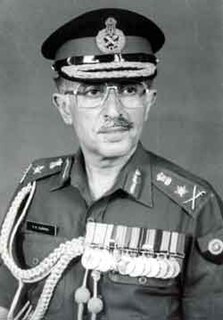This page is based on this
Wikipedia article Text is available under the
CC BY-SA 4.0 license; additional terms may apply.
Images, videos and audio are available under their respective licenses.
Sharma is a common surname in India and Nepal. The Sanskrit stem śarman- can mean 'joyfulness', 'comfort', 'happiness'. Although historically associated with people of the Brahmin varnas, the name has been widely adopted by other communities.
Puniya is a surname. Notable people with the surname include:
Dhar is a Kashmiri surname (kram), found among Hindu Pandits and Muslims native to the Kashmir Valley of India, as well as Kashmiri émigrés who have migrated to the Punjab, a region divided between India and neighbouring Pakistan. Hindu Dhars / Dars today hold a Vaishya status because of their ancestors. The Dhar kram originates from the honorific given to a village head, strongman or a warlord of a jagir. This honorific was prevalent during the 12th Century A.D. and remained in vogue up until the 14th Century A.D. In antiquity, many Dhars migrated to the region of Gauda, and much later returned to the Kashmir Valley. Nevertheless, to this day, there are many Bengali Kshatriyas of the Dhar clan who are found in that region of Bengal.

Aasra is a 1966 Hindi movie produced by Madan Mohla and directed by Satyen Bose. The film stars Mala Sinha, Biswajeet, Balraj Sahni, Jagdeep and Nirupa Roy. The film's music is by Laxmikant Pyarelal. The movie is loosely based on the 1961 Bengali movie Madhyarater Tara.
Dasgupta is a common Bengali last name or surname in West Bengal, India. The surname is found among the members of the Baidya caste.

General Vishwa Nath Sharma, PVSM, AVSM, ADC was the 15th Chief of the Army Staff of the Indian Army. He was the first Indian COAS to have begun his career in the post-Independence Indian Army.
Kendrapara Lok Sabha Constituency is one of the 21 Lok Sabha (Parliamentary) Constituencies in Odisha state in Eastern India.

Sheoraphuli Surendra Nath Vidyaniketan was established in 1963 by famous Jute Merchant Late Surendra Nath Ghosh who did many benevolent social work in his locality. This school is a Bengali medium school at Sheoraphuli, West Bengal, India. Students of the school appear for 10th (Madhyamik) examination under the West Bengal Board of Secondary Education and 12th examination under the West Bengal Council of Higher Secondary Education.
Sarhadein is an Indian television series which aired on Zee TV. The story narrates the similarities between the people living in two countries. Besides, it won a numerous awards at the time it was on-air, such as the Indian television actor Govind Namdeo won "Best Actor in a Negative Role" award for his role "Kedar Nath" at the Indian Telly Awards in 2002. The series was produced by UTV Software Communications and set in the backdrop of Kuala Lumpur, Malaysia. It averaged 1.5 TRPs at the time it was on air.

Phulparas is an assembly constituency in Madhubani district in the Indian state of Bihar. River Bhutahi Balan, which is one of the wildest rivers in Bihar, flowing through the heart of it.
Surendranath Law College formerly known as Ripon College) is an undergraduate law college affiliated with the University of Calcutta. It was established in Kolkata in the Indian state of West Bengal in 1885 by a trust formed by the nationalist leader, scholar and educationist Surendranath Banerjee, a year after he founded Surendranath College. This is now regarded one of the oldest Law college of British India.
Jha is a surname of Maithil Brahmin community native to India and Nepal.

Kakatpur is a Vidhan Sabha constituency of Puri district, Odisha.

Surendra was an Indian singer-actor of Hindi films. Known by his mononym, Surendra was born and educated in Punjab to be a lawyer by profession. He came to Bombay to become a singer on the recommendation of a Delhi distributor and his friends. He was "picked" by Mehboob Khan whom he met at Sagar Movietone, to sing and act in films as an alternative to the then Calcutta-based singer-actor, K. L. Saigal. Surendra started his career with his debut starring role in Deccan Queen (1936), directed by Mehboob Khan. He soon became a part of Sagar Movietone when his song "Birha Ki Aag Lagi More Man Mein" from the film became an "instant hit".

Surendra Nath Jena(Odia: ଗୁରୁ ସୁରେନ୍ଦ୍ର ନାଥ ଜେନା; 10 October 1924 – 8 October 2007) created an entirely new Odissi dance style with an oeuvre of many compositions. This dance style incorporates the various aspects of Indian culture, such as temple sculpture, ancient dance, Sanskrit and vernacular literature, yoga, traditional painting, manuscripts, and philosophy.
The entire music and dance choreography of these compositions were by Jena himself.







